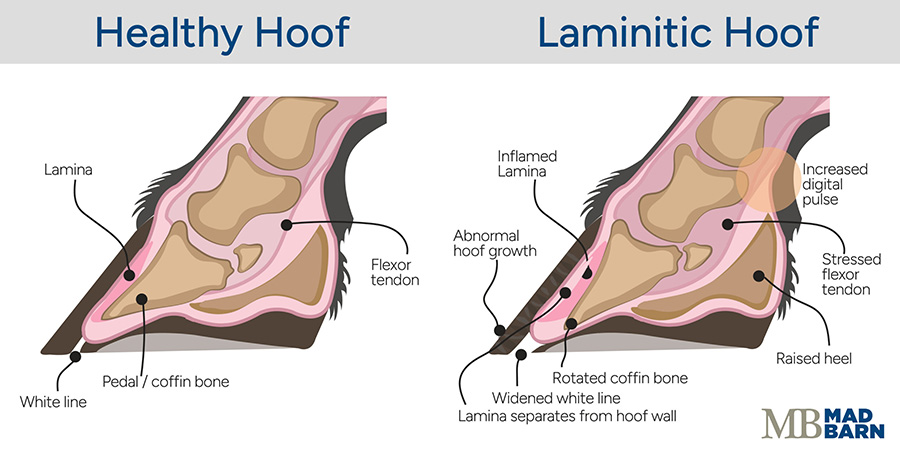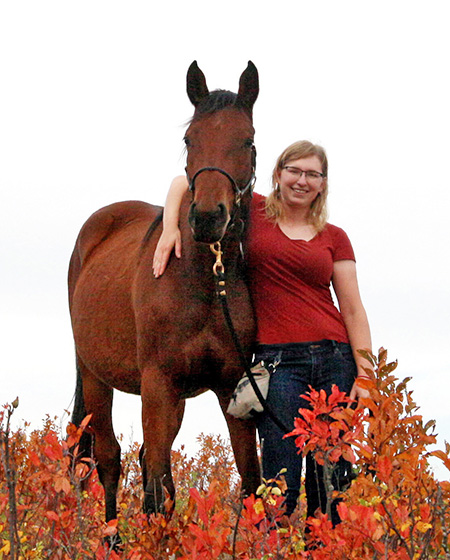
Horse owners have to make informed decisions every day about their horses’ diets, exercise, training, socialization, and health care.
As a leader in equine nutrition science, Mad Barn thanks The Rider for featuring this story. To read the full version of this article, visit https://madbarn.ca/common-equine-diseases/.
Horses are susceptible to many common illnesses and injuries that can impact their well being, performance, and longevity. Understanding common horse diseases is fundamental for everyone involved in equine care, as early recognition of the symptoms of disease can lead to better outcomes.
Whether you own a single horse or manage an entire stable, this list can help you keep your equine companions healthy and thriving.
Internal Parasites
Internal parasites are very common in horses and usually found within their gastrointestinal tract. Typically, horses acquire parasitic infections through ingesting parasite eggs from the environment.
Common internal parasites in horses include:
∙ Small and large strongyles
∙ Tapeworms
∙ Ascarids
∙ Threadworms
∙ Pinworms
∙ Stomach bots
Most internal parasites do not cause significant disease in horses unless they are present in a very large number or are damaging tissues. Symptoms of parasitic disease can include:
∙ Diarrhea
∙ Colic
∙ Weight loss
∙ Swelling of the lower abdomen
Strangles
Strangles is an infection with a highly infectious bacterium that affects the respiratory tract. Horses develop strangles after inhaling or ingesting Streptococcus equi from their environment or after contact with an infected horse.
Symptoms of strangles include:
∙ Fever
∙ Lethargy
∙ Swelling of the lymph nodes
∙ Rupture of lymph nodes with exuding pus
∙ Nasal discharge
∙ Difficulty breathing
Quarantine of all horses affected by strangles is critical to prevent further spread of disease. Typically horses are quarantined until they have a negative result on three separate diagnostic tests. Most horses make a full recovery from strangles infection.
There is a strangles vaccine available which reduces the severity of symptoms if a horse becomes infected.
Arthritis
Arthritis refers to inflammation in a joint and is a common cause of lameness in horses. Any joint in the horse’s body can develop arthritis. There are many possible causes of arthritis, including injuries in or around the joint, excessive use of a joint, and aging.
Horses with arthritis may resist flexion of the affected joint or seem stiff or sore.
When evaluating a horse that may have arthritis, veterinarians use a lameness examination to determine which joints are most likely affected. With an appropriate management plan, many horses with arthritis continue performance careers successfully.
Skin Cancer
Skin cancers are common in horses, particularly sarcoids, squamous cell carcinomas, and melanomas. Some cancers develop in sites frequently exposed to UV light or in areas of previous skin injury. Others occur due to genetic predisposition.
Skin cancers can develop anywhere on the body, and most skin cancers start as a small mass that grows over time. The skin overlying the tumor is often very fragile, and bleeds easily when the tumor is bumped or rubbed against objects.
The prognosis depends on the type of tumor present, the degree of malignancy, and whether there are metastases elsewhere in the horse’s body. Aggressive tumors typically have a poor prognosis, with many owners electing for humane euthanasia.
Laminitis
Laminitis refers to inflammation and separation of the lamellae, fine interdigitating tissues that support the coffin bone within the horse’s hoof.
Horses can have either acute (sudden onset) or chronic (prolonged) laminitis.
Symptoms of acute laminitis include:
∙ Severe lameness with stiff limb movement
∙ Increased temperature in the hooves
∙ Increased digital pulse (pulse in the lower limb)
∙ Rocking back onto their hindquarters, also called “Sawhorse stance”
Horses with chronic laminitis can show similar symptoms. Additional signs of chronic laminitis include a convex shape to the front of the hoof capsule, with the hoof rings being wider at the heel and narrow at the toe.

The prognosis for laminitis varies widely, depending on the underlying cause and degree of separation. Some horses successfully return to performance careers after developing laminitis with appropriate treatment and management.
Horse Health
Horse owners have to make informed decisions every day about their horses’ diets, exercise, training, socialization, and health care. By familiarizing yourself with the most common equine health concerns, you can take proactive steps to prevent them and know when to call a veterinarian for help. Staying up to date with routine preventive care ensures the best conditions for your equids to live a long, happy life. About the Author:
About the Author:
Dr. Madison Ricard graduated from the University of Calgary Faculty of Veterinary Medicine in 2020, and holds a PhD in Anatomic Pathology at the Western College of Veterinary Medicine in Saskatoon, SK. Madison’s veterinary health and research interests primarily focus on horses, particularly equine reproduction. Currently, her herd consists of several retired show jumpers, a show jumping prospect, and two goats.
Source: MadBarn


